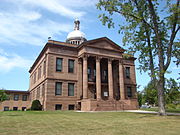George W. Orff
George W. Orff | |
|---|---|
| Born | March 3, 1835 |
| Died | March 11, 1908 (aged 73) |
| Nationality | United States |
| Occupation | Architect |

George W. Orff (1835-1908), was an American architect of Bangor, Maine and Minnesota.[1]
Life and career[]
George W. Orff was born March 3, 1835 in Bangor, Maine to Edward F. Orff and Sarah (Yates) Orff. He was educated in the public schools and trained as a carpenter. However, he had other ambitions and in 1861 went to Boston to train as an architect. He is believed to have studied with Calvin Ryder, a Maine native who designed several buildings in Bangor. In 1870 he returned to Bangor and established himself as an architect, practicing there for eight years. One of his first works, the Adams-Pickering Block in Bangor, is the largest surviving project in Maine. In the winter of 1878 he left Bangor and moved west, settling in Minneapolis in the spring of 1879. He was soon joined by his brother, Fremont D. Orff, who worked as a draftsman until they formed a partnership in 1881. In the 1880s and 1890s they employed several talented designers, including Francis W. Fitzpatrick from 1888 to 1889 and Edgar E. Joralemon. In 1893 the partnership was expanded to include Joralemon. The Orff brothers and Joralemon practiced as Orff & Joralemon until the partnership was dissolved in 1897. Fremont D. Orff suceeded to the practice, with the elder Orff being appointed a superintendent of construction for the Minneapolis public schools. Circa 1905 Orff left Minneapolis and returned to his native Bangor, where he died in 1908.[2][3][4]
Personal life[]
Orff died March 11, 1908 in Bangor. His wife had died circa 1903 in Minneapolis. They had no children.[4] He was buried in Mount Hope Cemetery in Bangor.
Legacy[]
A number of his works are listed on the United states National Register of Historic Places.[5]
Architectural works[]
- Old Town Town Hall, Old Town, Maine (1870-71, demolished)[6]
- Adams-Pickering Block, Bangor, Maine (1871, NRHP 1974)[7]
- House for Samuel Kidder Whiting,[a] Ellsworth, Maine (1871, NRHP 1983)[8]
- Holden Town Hall,[a] Holden, Maine (1873, NRHP 2014)[9]
- Orono Town Hall, Orono, Maine (1873-74, burned 1891)[10]
- Double house for George W. Orff and George J. Poole, Bangor, Maine (1874)[11]
- House for Taylor Durgin, Bangor, Maine (1874)[11]
- House for Jones P. Veazie, Bangor, Maine (1874-75, NRHP 1988)[12]
- Emerson Block, Bangor, Maine (1875, demolished)[7]
- Hatch Block, Bangor, Maine (1875, demolished)[7]
- Bank Block, Dexter, Maine (1876, NRHP 1999)[3]
- Batchelder-Mitchell Block, Bangor, Maine (1876, demolished)[7]
- House for James A. Robinson, Bangor, Maine (1878)[13]
- House for Roscoe Hersey, Stillwater, Minnesota (1879-80, NRHP 1982)[14]
- ,[b] Eau Claire, Wisconsin (1882, NRHP 1980)[15]
- Panama Flats, St. Paul, Minnesota (1886)[16]
- Mutual Block, Minneapolis, Minnesota (1888 et seq., demolished)[17]
- Athletic Park, Minneapolis, Minnesota (1889, demolished 1901)[17]
- House for George W. Van Dusen,[c] Minneapolis, Minnesota (1891-93, NRHP 1995)[18]
- House for Edmund G. Walton, Minneapolis, Minnesota (1892, demolished 1959)[19]
- North Dakota Soldiers' Home, Lisbon, North Dakota (1892-93, demolished)[20]
- House for John E. Lockwood, Minneapolis, Minnesota (1893)[16]
- Bayfield County Courthouse, Washburn, Wisconsin (1894-96, NRHP 1975)[21]
- Waseca County Courthouse, Waseca, Minnesota (1896-97, NRHP 1982)[22]
Gallery of architectural works[]
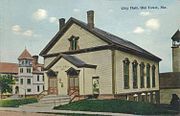
Old Town Town Hall, Old Town, Maine, 1870-71.
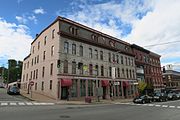
Adams-Pickering Block, Bangor, Maine, 1871.
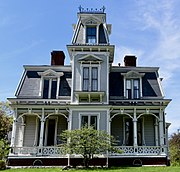
House for Jones P. Veazie, Bangor, Maine, 1874-75.

Bank Block, Dexter, Maine, 1876.

House for Roscoe Hersey, Stillwater, Minnesota, 1879-80.
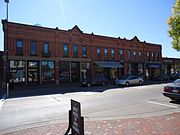
, Eau Claire, Wisconsin, 1882.
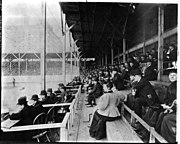
Athletic Park, Minneapolis, Minnesota, 1889.
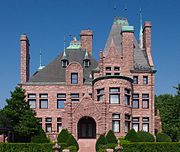
House for George W. Van Dusen, Minneapolis, Minnesota, 1891-93.
Bayfield County Courthouse, Washburn, Wisconsin, 1894-96.
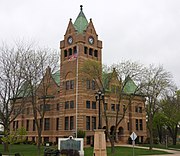
Waseca County Courthouse, Waseca, Minnesota, 1896-97.
Notes[]
- ^ Jump up to: a b Attributed to Orff on stylistic grounds.
- ^ A contributing property to the Water Street Historic District, listed on the National Register of Historic Places in 2007.
- ^ The design is attributed to Edgar E. Joralemon, the Orff Brothers' chief designer.
References[]
- ^ Deborah Thompson, Bangor, Maine, 1769-1914: An Architectural History (Orono: University of Maine Press, 1988)
- ^ George E. Warner; Charles M. Foote; Edward Duffield Neill; John Fletcher Williams (1881). History of Hennepin County and the City of Minneapolis. North Star Publishing Company. p. 608.
- ^ Jump up to: a b Bank Block NRHP Registration Form (1999)
- ^ Jump up to: a b "Death of George W. Orff," Improvement Bulletin 36, no. 15 (March 14 1908): 15.
- ^ "National Register Information System". National Register of Historic Places. National Park Service. July 9, 2010.
- ^ "Local and Other Matters," Bangor Daily Whig and Courier, February 16, 1871, 3.
- ^ Jump up to: a b c d Adams-Pickering Block NRHP Registration Form (1974)
- ^ Samuel Kidder Whiting House NRHP Registration Form (1983)
- ^ Holden Town Hall NRHP Registration Form (2014)
- ^ "Local and Other Items," Bangor Daily Whig and Courier, March 4, 1874, 3.
- ^ Jump up to: a b "Building in Bangor," Bangor Daily Whig and Courier, January 9, 1875, 3.
- ^ Jones P. Veazie House NRHP Registration Form (1988)
- ^ "Local Matters," Bangor Daily Whig and Courier, November 27, 1878, 3.
- ^ Roscoe Hersey House NRHP Registration Form (1982)
- ^ Pioneer Block NRHP Registration Form (1980)
- ^ Jump up to: a b Larry Millett, AIA Guide to the Twin Cities (St. Paul: Minnesota Historical Society, 2007)
- ^ Jump up to: a b Larry Millett, Lost Twin Cities (St. Paul: Minnesota Historical Society, 1992)
- ^ George W. and Nancy B. Van Dusen House NRHP Registration Form (1995)
- ^ Larry Millett, Once There Were Castles (St. Paul: Minnesota Historical Society, 2011)
- ^ History of the Red River Valley; Past and Present, vol. 2 (Grand Forks: Herald Printing Company, 1909)
- ^ Bayfield County Courthouse NRHP Registration Form (1975)
- ^ Waseca County Courthouse NRHP Registration Form (1982)
- Architects from Bangor, Maine
- Architects from Minneapolis
- American architect stubs








